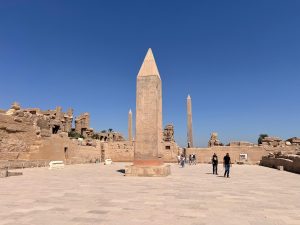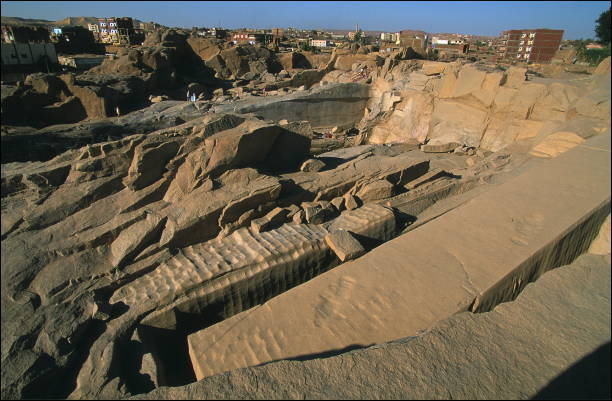The Significance of Obelisks
Obelisks are considered the most challenging architectural work of the Egyptians, as they are a single block of stone in a rectangular shape with a pyramidal top. They were often adorned with gold or a combination of gold and another metal to reflect sunlight. Therefore, obelisks served as a declaration of the presence of a temple, and kings often erected two obelisks in front of their temples, symbolizing the north and south. More than 50 obelisks were found in Egypt, but unfortunately, most were transported outside Egypt, becoming ambassadors for Egypt abroad. For example, Rome alone has more than 14 obelisks, in addition to the famous obelisk in Paris, another on the Thames River in London, another in New York, and many others around the world. Less than 15 obelisks remain in Egypt. Kings always inscribed their names, titles, and accomplishments on the obelisks.
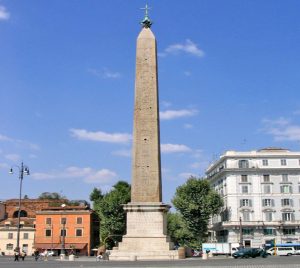
The Aswan Quarries
The ancient Egyptians used to quarry stones from various quarries, such as limestone in Tura and granite in Aswan. Granite is one of the hardest types of stone, requiring great effort to cut and transport via ships to the desired areas. If they wanted to transport a stone or obelisk from Aswan to Cairo or Thebes, the process would be as follows: The king would send his most skilled workers to the governor of Aswan to begin work in the quarries. The governor of Aswan would assist them with accommodation and provide them with the necessary tools for cutting the stones. The ancient Egyptians used boats to transport stones from one area to another. The Egyptians were clever in placing the stone or obelisk on a kind of iron sled to prevent it from breaking, and a group of strong men would pull it with a fleet of boats. The wind always helped them because the wind in Egypt flows from south to north. They would take advantage of the flood from Aswan to the north, and the flood would help them sail north easily and effortlessly with all those huge blocks.
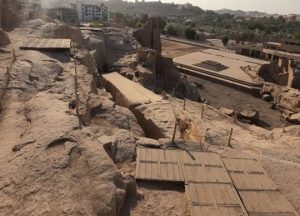
The Unfinished Obelisk
Approximately 42 meters tall and weighing about 1.6 million kilograms, the unfinished obelisk was intended to be the largest in ancient Egypt. Queen Hatshepsut ordered its creation to adorn the Temple of Amun-Ra at Karnak. Workers were sent to carve the obelisk, as usual, by inserting probes 10 meters deep into the mountain to assess the hardness of the stone. Unfortunately, after they began work, a crack appeared in the obelisk, forcing them to halt the project. It was left in place, and thanks to this, we now have a unique insight into how the ancient Egyptians carved such massive obelisks.
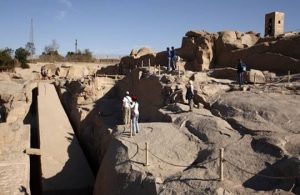
How Obelisks Were Cut
Selecting and Testing the Stone: A suitable block of stone was chosen. The hardness of the stone was tested. Wooden wedges were driven into the stone and soaked with water. This caused the stone to expand and separate from the mountain, a process that could take several days. The dimensions of the desired obelisk were marked out. Iron tools were used to separate the block from the mountain. Chisels and other tools were used to refine the surface for inscriptions. The obelisk was placed on sledges and pulled by oxen. To facilitate movement, the sledges were lubricated with substances like milk or water. During the Nile flood, as we mentioned before, making transportation easier.
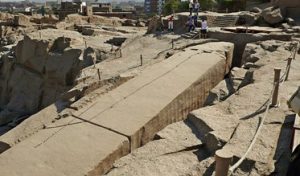
Inscription and Erection in the temples
When the obelisk reaches the desired location for its erection, there are writing workshops inside the temple, and the scribes inscribe what the king desires on the obelisk – his names, titles, and the deity to whom it is dedicated. Upon completion, they use sledges pulled by oxen. To facilitate movement and prevent friction between these wheels and the sand, they pour milk or water on the ground to smooth the movement until they reach the place where it will be erected.
Erecting the Obelisk
A well was dug and filled with sand up to its top. At the bottom of the well, there was an opening or tunnel to remove the sand. Then, a square base for the obelisk was placed around this well. The workers brought the obelisk next to this well and placed it horizontally on top of the base and the well. The obelisk was tied with ropes, and initially, it was brought and placed on top of the rectangular summit horizontally. Then, it was erected at an angle until it reached a 90-degree angle. At that moment, the sand was removed from the bottom of the well so that there would be no friction between the obelisk stone and the stone of the well or the base. And this indicates the genius of the ancient Egyptian in sculpture and architecture.
Hatshepsut’s Obelisks
Queen Hatshepsut ordered the construction of two obelisks for the temple complex she built at Karnak. One, standing at 29 meters, was erected next to that of her father’s, Thutmose I. The other was broken during construction and the remaining portion was erected in 2023 near the sacred lake at Karnak, only standing part at 11 meters high. The temple of Deir el-Bahri, built by Hatshepsut, depicts the process of erecting these obelisks.

A picture of the obelisk of Hatshepsut (the highest) and the obelisk of her father Thutmose I (the lowest)
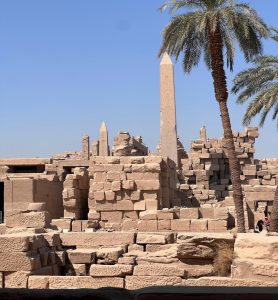
Picture of the small obelisk of Hatshepsut (11 meter) and in the back the large obelisk (29 meter)
